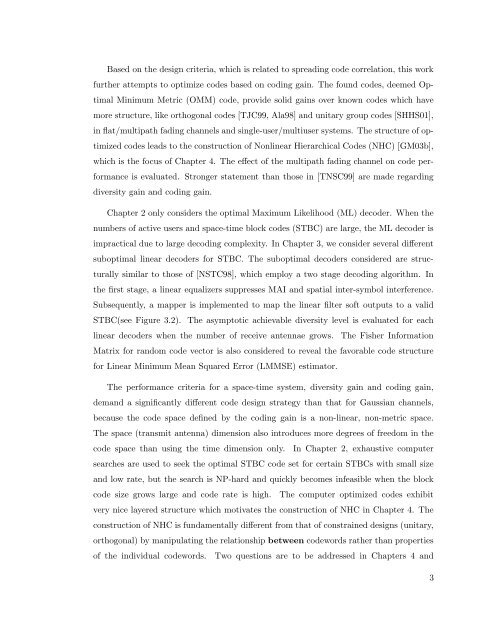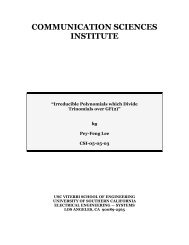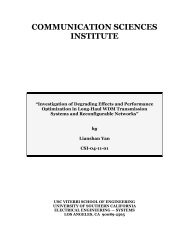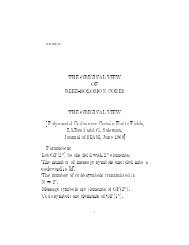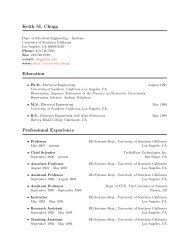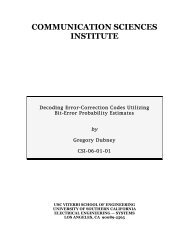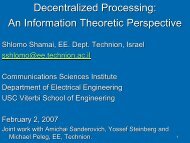Space-Time Block Codes for Wireless Systems - The ...
Space-Time Block Codes for Wireless Systems - The ...
Space-Time Block Codes for Wireless Systems - The ...
Create successful ePaper yourself
Turn your PDF publications into a flip-book with our unique Google optimized e-Paper software.
Based on the design criteria, which is related to spreading code correlation, this work<br />
further attempts to optimize codes based on coding gain. <strong>The</strong> found codes, deemed Optimal<br />
Minimum Metric (OMM) code, provide solid gains over known codes which have<br />
more structure, like orthogonal codes [TJC99, Ala98] and unitary group codes [SHHS01],<br />
in flat/multipath fading channels and single-user/multiuser systems. <strong>The</strong> structure of optimized<br />
codes leads to the construction of Nonlinear Hierarchical <strong>Codes</strong> (NHC) [GM03b],<br />
which is the focus of Chapter 4. <strong>The</strong> effect of the multipath fading channel on code per<strong>for</strong>mance<br />
is evaluated. Stronger statement than those in [TNSC99] are made regarding<br />
diversity gain and coding gain.<br />
Chapter 2 only considers the optimal Maximum Likelihood (ML) decoder. When the<br />
numbers of active users and space-time block codes (STBC) are large, the ML decoder is<br />
impractical due to large decoding complexity. In Chapter 3, we consider several different<br />
suboptimal linear decoders <strong>for</strong> STBC. <strong>The</strong> suboptimal decoders considered are structurally<br />
similar to those of [NSTC98], which employ a two stage decoding algorithm. In<br />
the first stage, a linear equalizers suppresses MAI and spatial inter-symbol interference.<br />
Subsequently, a mapper is implemented to map the linear filter soft outputs to a valid<br />
STBC(see Figure 3.2). <strong>The</strong> asymptotic achievable diversity level is evaluated <strong>for</strong> each<br />
linear decoders when the number of receive antennae grows. <strong>The</strong> Fisher In<strong>for</strong>mation<br />
Matrix <strong>for</strong> random code vector is also considered to reveal the favorable code structure<br />
<strong>for</strong> Linear Minimum Mean Squared Error (LMMSE) estimator.<br />
<strong>The</strong> per<strong>for</strong>mance criteria <strong>for</strong> a space-time system, diversity gain and coding gain,<br />
demand a significantly different code design strategy than that <strong>for</strong> Gaussian channels,<br />
because the code space defined by the coding gain is a non-linear, non-metric space.<br />
<strong>The</strong> space (transmit antenna) dimension also introduces more degrees of freedom in the<br />
code space than using the time dimension only. In Chapter 2, exhaustive computer<br />
searches are used to seek the optimal STBC code set <strong>for</strong> certain STBCs with small size<br />
and low rate, but the search is NP-hard and quickly becomes infeasible when the block<br />
code size grows large and code rate is high. <strong>The</strong> computer optimized codes exhibit<br />
very nice layered structure which motivates the construction of NHC in Chapter 4. <strong>The</strong><br />
construction of NHC is fundamentally different from that of constrained designs (unitary,<br />
orthogonal) by manipulating the relationship between codewords rather than properties<br />
of the individual codewords. Two questions are to be addressed in Chapters 4 and<br />
3


